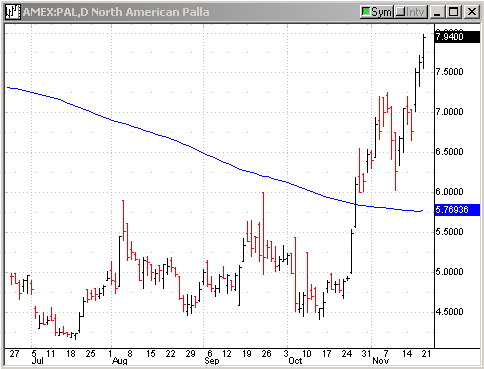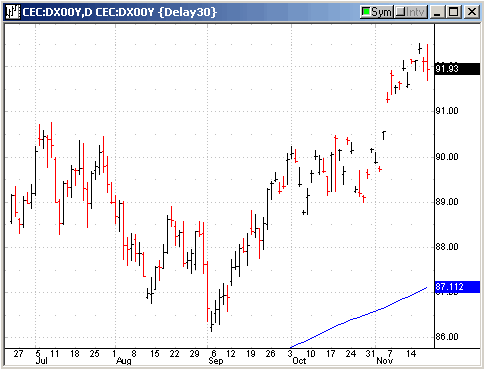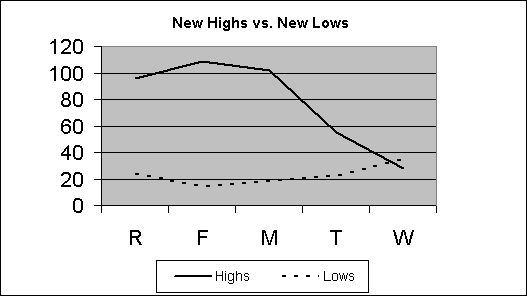Seasonal uptrend intact but stick with the leaders
This year seasonal influences
are unusually strong, as September-October saw a global decline and bottom and
November is moving higher into the November-December strongest seasonal period.
We remain less than wildly
enthusiastic and suggest investors participate but with less than normal
allocation. Particularly for traders we do like global leaders such as Japan,
Korea, US transports, insurance, Latin Banks, Brazil, Gold/EUR and gold/Yen, and
the platinum-palladium group of metals.
North American Palladium
(
PAL |
Quote |
Chart |
News |
PowerRating)

Global bonds broke out of minor
bottoming patterns this week and broke downtrend lines, giving equity markets a
break from what appeared to be the start of higher long-term rates.
The dollar has broken out to
new highs and appears to be moving irregularly higher until Fed rate hiking
abates. Oil stocks and oil prices have put in short-term bottoms off of 200 ma
support levels. The action of oil in the next week or two will be important for
investors to watch. Lower oil prices have helped the market recently, and it is
critical that oil prices don’t race higher here again quickly.
US Dollar Index

This rally has been and likely
will continue to be playable for traders, but investors should tread more
lightly than normal, particularly after the seasonally positive period ends.
Fed rate hiking is starting to show signs of biting and every Fed hiking bout
since the 1970’s has eventually sent global stock prices into a negative annual
rate of change before ending. The bull market is long in the tooth and not yet
a high odds affair that justifies unusually high allocation. Internals are
mixed with some sectors moving to new highs while others make new lows, with
accumulation and breadth indicators lagging considerably. The percentage of
stocks above 10-week and 30-week ma’s is down substantially from the highs of
earlier in the year and new highs are under half of peak levels from mid-year.
We therefore continue to suggest less than normal allocation, even to the
strongest instruments and sectors.
Our model
portfolio followed in TradingMarkets.com with specific entry/exit/ops levels
from 1999 through May of 2003 was up 41% in 1999, 82% in 2000, 16.5% in 2001,
7.58% in 2002, and we stopped specific recommendations up around 5% in May 2003
(strict following of our US only methodologies should have had portfolios up 17%
for the year 2003) — all on worst drawdown of under 7%. This did not include
our foreign stock recommendations that had spectacular performance in 2003.
This week in our Top RS/EPS New Highs list published on TradingMarkets.com, we
had readings of 96, 109, 102, 55, and 28 with 30 breakouts of 4+ week ranges, no
valid trades and no close calls. This week, our bottom RS/EPS New Lows recorded
readings of 24, 14, 18, 23, and 35 with 9 breakdowns of 4+ week ranges, no valid
trades and one close call in
(
MATK |
Quote |
Chart |
News |
PowerRating). The “model†portfolio of trades meeting
criteria is now long
(
CVCO |
Quote |
Chart |
News |
PowerRating) and
(
TRAD |
Quote |
Chart |
News |
PowerRating) and short
(
NDN |
Quote |
Chart |
News |
PowerRating). The environment is getting
trickier and more treacherous and we are chickens when it comes to risking
principle unless it looks like the weather is clear.

For Poker players this isn’t a royal-flush hand the market is dealing now, more
like two pair. Traders could participate on strong RS sectors and watch weak
sectors to short against them on the slightest excuse, while investors should
tread more lightly than normal.
Mark Boucher
Mark Boucher has been ranked #1 by Nelson’s World’s Best
Money Managers for his 5-year compounded annual rate of return of 26.6%.
Boucher began trading at age 16. His trading helped finance his education at the
University of California at Berkeley, where he graduated with honors in
Economics. Upon graduation, he founded Investment Research Associates to finance
research on stock, bond, and currency trading systems. Boucher joined forces
with Fortunet, Inc. in 1986, where he developed models for hedging and trading
bonds, currencies, futures, and stocks. In 1989, the results of this research
were published in the Fortunet Trading Course. While with Fortunet, Boucher also
applied this research to designing institutional products, such as a hedging
model on over $1 billion of debt exposure for the treasurer of Mead, a Fortune
500 company.
For those
not familiar with our long/short strategies, we suggest you review my book The
Hedge Fund Edge. Basically, we have rigorous criteria for potential long stocks
that we call “up-fuel,” as well as rigorous criteria for potential short stocks
that we call “down-fuel.” Each day we review the list of new highs on our “Top
RS and EPS New High List” published on TradingMarkets.com for breakouts of
four-week or longer flags, or of valid cup-and-handles of more than four weeks.
Buy trades are taken only on valid breakouts of stocks that also meet our
up-fuel criteria. Shorts are similarly taken only in stocks meeting our
down-fuel criteria that have valid breakdowns of four-plus-week flags or cup and
handles on the downside. In the U.S. market, continue to only buy or short
stocks in leading or lagging industries according to our group and sub-group new
high and low lists.
We continue to buy new long signals and sell short new short
signals until our portfolio is 100% long and 100% short (less aggressive
investors stop at 50% long and 50% short). In early March of 2000, we took
half-profits on nearly all positions and lightened up considerably as a sea of
change in the new-economy/old-economy theme appeared to be upon us. We’ve been
effectively defensive ever since, and did not get to a fully allocated long
exposure even during the 2003 rally.
